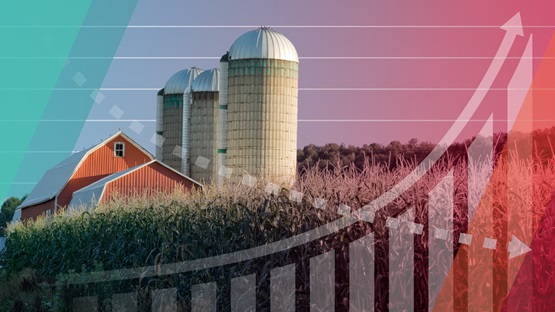Interest rates have risen dramatically since mid-2022, raising borrowing costs. Agricultural producers face additional expenses arising from supply issues and economic uncertainty. For some producers, especially the least profitable, increased production expenses could require them to secure additional funding due to lower working capital levels per acre farmed.
Higher interest rates
Between 2008 and 2019, interest rates for agricultural loans were low and relatively stable (Figure 1). In the first quarter of 2020, interest rates declined further as the federal government and central bank took measures to stabilize financial markets at the beginning of the COVID-19 pandemic.
As a result, most agriculture-related interest rates offered throughout 2020 were less than 5 percent—the lowest rates reported in over 45 years. Starting in the fourth quarter of 2021, non-real estate interest rates increased dramatically. Agriculture-related interest rates reported in the fourth quarter of 2022 more than doubled from the previous year, rising by more than 300 basis points. The only time loan rates increased at this pace was in the early 1980s (6 percent annual increase).
Increasing liabilities
Individual producer debt levels fluctuate yearly as production costs vary or producers take on additional longer-term debt. These fluctuations are especially pronounced for the least-profitable agricultural producers because they have more liabilities per crop acre farmed.
Figure 2 includes the average amount of liabilities for the bottom fifth and top fifth per crop acre farmed since 1997. Since 2021, price increases have impacted the least-profitable producers more than others because they are less likely to receive bulk discounts, have less working capital, or are highly leveraged. Total liabilities per acre for the bottom fifth of producers increased by 50 percent from 2020 to 2022.
Two items are worth noting when reviewing the data and trends in Figure 2. First, for 24 of the 26 years in the database, the least-profitable farms have higher debt levels per crop acre farmed than the most profitable. Second, the variability of annual interest expenses for all years is far higher for the least-profitable operations ($424) than the most profitable operations ($145). The variability increased for both groups in 2008, although at considerably higher rates for the least-profitable producers ($581 compared with $193), even as interest rates were low and stable for over 10 years.
Interest expense per acre
Even with low and stable interest rates, the increased total liability per acre resulted in elevated interest expenses. Figure 3 includes the average interest expense per acre for the least- and most-profitable producers in the Ninth District. We can see two noteworthy patterns in the data. Most importantly, higher liabilities per crop acre farmed leave the least-profitable producers most sensitive to rate increases. As rates increase, they face larger interest costs per acre, further straining their cash flows and reducing profits. Second, in most years, the least-profitable producers spend far more on interest expenses per crop acre farmed than the most profitable producers—up to three times as much.
Practical implication: How much product goes to interest expense?
Assigning a relative value to the annual interest expense can help producers understand or visualize the “time-production” cost of interest expense. Producers can analyze their operation using the typical unit of production for their specific industry, such as hundredweight, animal unit/head, or weaned pounds. Crop producers could use the farm yield averages (due to field variations in yield potential) and the prices received for commodity sales.
Figure 4 includes the average percent of crop per acre of corn to pay for the per acre interest expenses for both quintiles. In 2022, the least-profitable producers allocated an average of 8 percent of their corn crop to pay for interest expenses, three times as much as the most-profitable producers. For all years, the least-profitable producers allocated more of their crop to pay for interest than the most-profitable producers.
Conclusions
Elevated interest rates will impact producer financials in 2023 and beyond, especially for the least-profitable producers. Producer cash flows since 2008 benefited from historically low and stable interest rates that are no longer a reality. While this article focused on rising interest expenses for the least-profitable producers, all producers should prepare for elevated interest rates by incorporating higher interest expenses into cash flow projections regardless of profitability and debt levels. Updating these projections is especially important for the least-profitable producers because their cash flow projections are far more sensitive to rising interest rates due to higher debt levels per acre. Results from the updated projections will help producers understand how elevated interest rates will impact their operations this year (and beyond) and provide financial options to operate in the new reality of higher interest rates.





